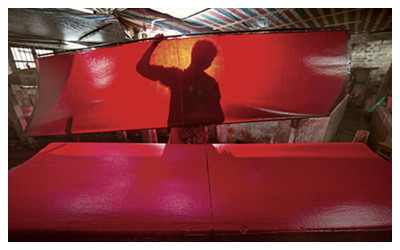Skype: neodalle-travel
Tel: +86 135 7447 2266
E-mail: sales@zhangjiajieholiday.com

History of Xuan Paper
 Xuan Paper, with a history of more than 1500 years, originated in Jing County, Xuanzhou in the Tang Dynasty, and took its name from Xuanzhou, the collecting and distributing center of Xuan Paper. In the Tang Dynasty, it had been one of tributes and the first of the Four Treasures of the Study.
Xuan Paper, with a history of more than 1500 years, originated in Jing County, Xuanzhou in the Tang Dynasty, and took its name from Xuanzhou, the collecting and distributing center of Xuan Paper. In the Tang Dynasty, it had been one of tributes and the first of the Four Treasures of the Study.
Since its birth, Xuan Paper has increasingly expanded its varieties. According to ancient books, in the Song Dynasty, raw Xuan Paper boasted such varieties as Lined Xuan Paper, Yuban (strong white Xuan Paper), Jingpi (Pteroceltis tatarinowii bark at about 60%), Single Xuan Paper and Mianlian (Pteroceltis tatarinowii bark at about 40%), while processed Xuan Paper had those with coral pattern, mica pattern, gold-sprinkled and wax, etc.
In the Ming and Qing Dynasties, there were paper-tribute in the Xuande period(1426—1435), Jinbang, Luyu, rib-like grain paper, Juanlian, and Liansi and processed Xuan Paper had Tang-styled Paper created by Xuetao, Song-styled Sutra Paper collected in Jinsu Temple, Yuban Paper with plum blossom patterns, Jade-green Paper with powder and wax, which were sprinkled with gold or silver, reflecting the advanced technology in manufacturing and processing.
After the founding of the PRC in 1949, Xuan Paper has developed at speed and created many varieties with diverse specifications such as Mianliao (straw as the main raw material), Jingpi, special Jingpi(Pteroceltis tatarinowii bark at about 80%) and Chunpi. Zhanger (size about 144.9*367.5cm) and Erzhang (size about 246 *653cm) also were created. Erzhang, as the largest Xuan Paper, was included in China Records in 2000. Related products of Xuan Paper are rich, especially fans, most loved by people. And the inscriptions and paintings on fans add cultural meanings to its practicality. When putting plants and flowers into the papers and pasting them onto windows and lamps, we find them traditional and elegant.
Known from worldwide anout Xuan Paper
Xuan Paper has been attracting the attentions of many experts, scholars and state leaders. In 1964, Guo Moruo inspected Xuan Paper Factory of Jing County, and left his handwritings there: “Xuan Paper is an artistic creation of Chinese people; without it, Chinese calligraphy and painting would have lost the ability of expressing the charm of art.” The Maestro Liu Haisu had visited Jing County many times with several inscriptions such as “Xuan Paper, with diverse charm, can endure for a thousand years” and “Xuan Paper is as white as cloud and as soft as cotton.” In May 2001, the General Secretary Jiang Zemin inspected Xuan Factory of Jing County and wrote: “Carry on outstanding culture and promote Chinese civilization”. Over the years, many scholars also have been studying and publicizing Xuan Paper by publishing related books.
 Ask Questions ?
Ask Questions ?